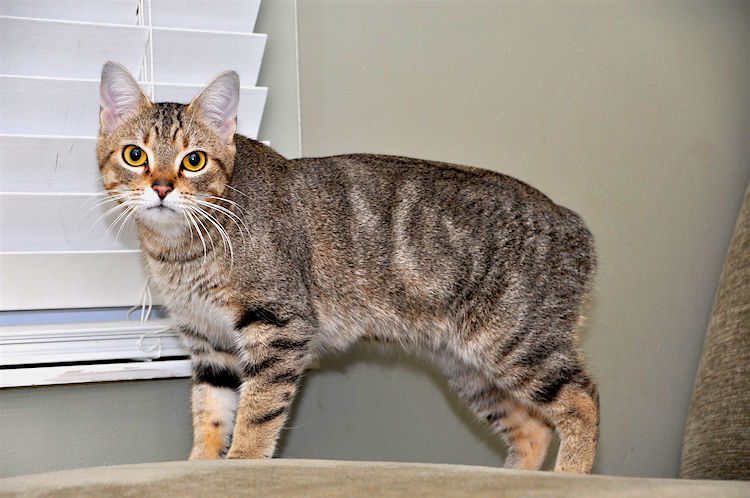1. Key Characteristics
- Weight: Males are 10–12 pounds; females are 8–10 pounds
- Life Expectancy: 8–14 years
The Manx is a medium-sized, rounded cat known for having hind legs that are longer than their front legs.
The double coat can be two different lengths: The shorter-coated cat is called the Manx, and the longhaired version is called the Cymric.
The tail of either can be full, short, stubby or missing. An incomplete dominant gene is responsible for the natural genetic mutation. Although the gene affecting the tail length may be present, it’s not a guarantee of tail length in the offspring.
The eyes are large and rounded, and the wide ears taper to a rounded tip. These cats reach full maturity around 5 years of age.
2. Where They Came From
There’s lots of speculation about the cats being brought over from England or Wales, although the Isle of Man is usually where people say they originated.
The trait of having a short tail or missing tail became common for cats on the island. The Manx was a breed included in the rise of cat fancy in the 1800s. The International Cat Association (TICA) recognized the Manx and Cymric in 1979, and the Cat Fanciers’ Association added the breed in 1906.

3. How Friendly Are They?
This breed is affectionate, intelligent and great for families. The cats are loyal and devoted to their family members in a dog-like way. They enjoy children and other household pets, and their devotion makes them susceptible to separation anxiety.
Generally protective of the home, Manx cats are usually good hunters. They like to play fetch and bury their toys, and they can also be real talkers.
4. Is This the Right Cat for You?
Exercise Needs
![]()
LOW: Manx cats don’t have specific exercise needs in addition to those of regular cats. Their physical activity should be similar to that of their feline peers (sleeping long hours, playing, running and jumping).
Keep them indoors to avoid injury or straying away from home — they’re very people-oriented.
Because of their longer, powerful hind legs, Manx cats can jump high, turn and accelerate quickly when running.
Grooming Needs
![]()
LOW: Both coat varieties of the Manx are double coats, and they’re pretty easy to maintain. Brush them a few times a week, and bathe them only occasionally.
When a regular grooming routine is in place, the coat is less likely to tangle or create mats. Additional grooming may be needed during the spring and fall seasons, when shedding increases.
Give these cats scratching surfaces to keep the nails maintained between trimmings. Check the eyes and ears for discharge or buildup, and clean the teeth regularly to prevent periodontal disease.
Health Problems
![]()
MEDIUM: The Manx is a pretty healthy cat breed, but the spine and longer hind legs can cause health concerns, such as:
- Tail area sensitivity
- Spinal defects
- Neurological problems
Support these cats’ spine when transporting them or picking them up — injuries are possible otherwise.
This video shows a Manx cat playing fetch and exhibiting the breed’s fast movements:
5. Where to Adopt One
Purebred cats can and do end up in shelters and rescues. Start with our adoptable pet search (choose the cat tab) or check your local rescues and shelters.
If you do decide to check out breeders, get to know them, ensure they are not operating a kitten mill and get a health certificate for your Manx because of the potential for spinal problems.
Additional Resources


